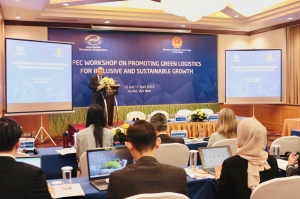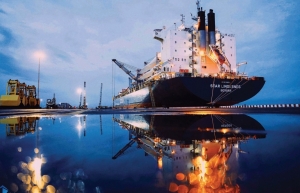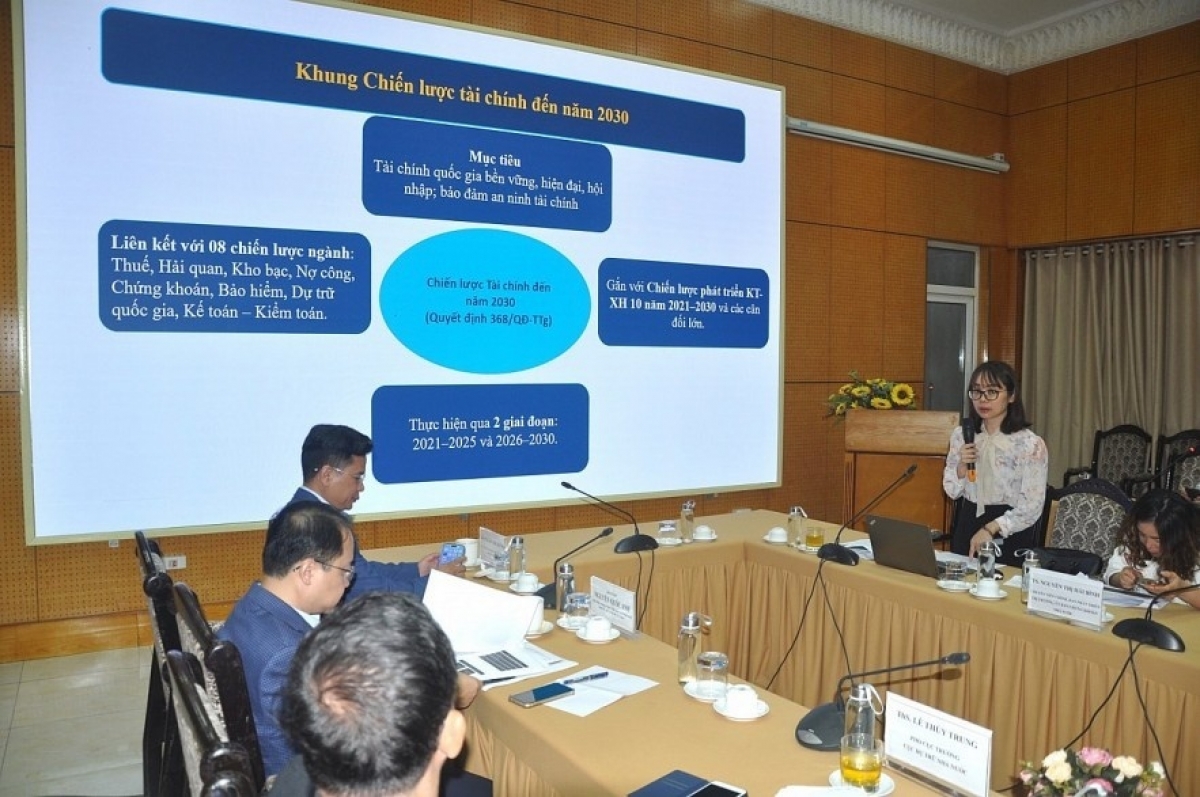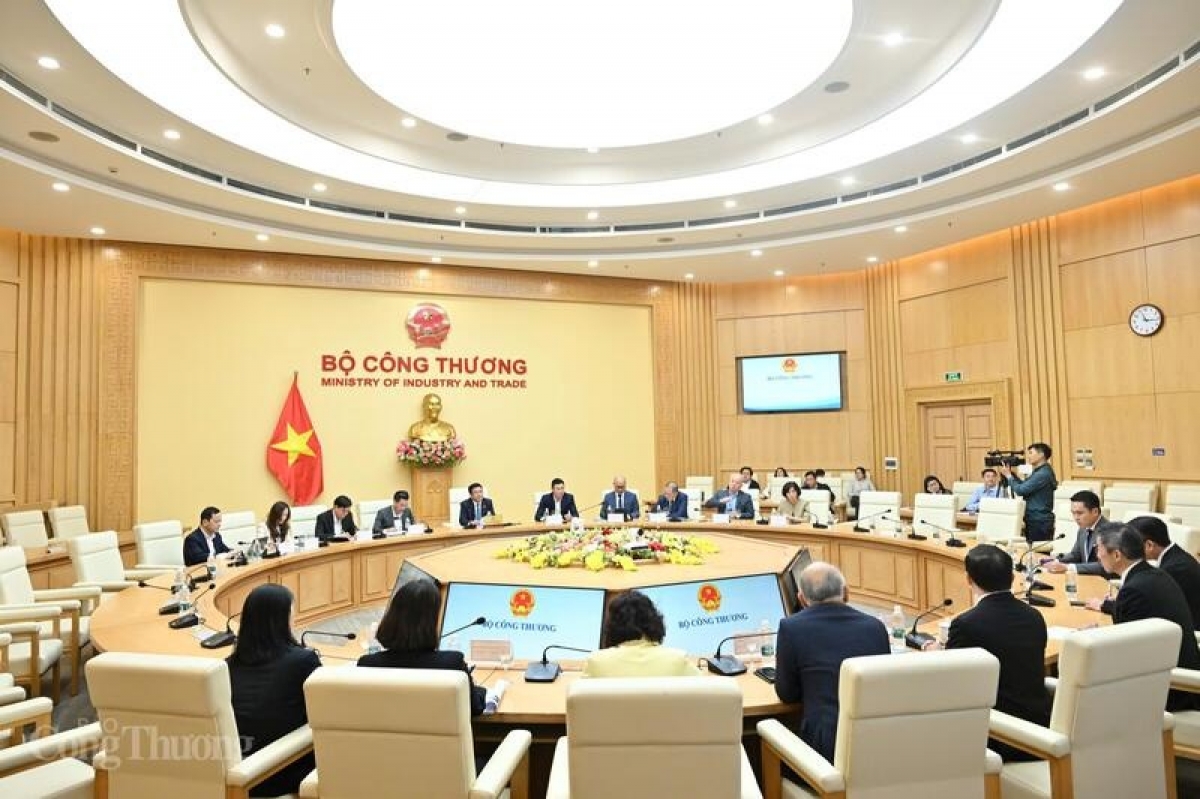INTERNATIONAL INVESTMENT
AND PORTAL
A modern logistics system will be indispensable, as logistics is the blood system that supplies life to the national economy. There is undoubtedly still work to be done, but there are good reasons for optimism.
 Consultant Long Pham and Vietnam country director Andreas Stoffers from the Friedrich Naumann Foundation for Freedom
Consultant Long Pham and Vietnam country director Andreas Stoffers from the Friedrich Naumann Foundation for Freedom
The economic results in the first quarter of 2024 show that Vietnam’s economic situation is more positive than the predictions made before.
According to the European Chamber of Commerce’s Business Confidence Index, in the first quarter of 2024, Vietnam reached 52.8 points, the highest level since 2022. This is a clear signal of the increased confidence of the European business community in Vietnam. Approximately 71 per cent of European businesses are positive about Vietnam’s long-term development over the next five years.
Three key pillars of the Vietnamese economy – investment, trade, and consumption – showed strong upward trends in the first quarter when registered foreign direct investment (FDI) totalled $6.17 billion, an increase of 13.4 per cent on-year. This turnover totalled $4.63 billion, which represents an increase of 7.1 per cent.
It is particularly noteworthy that 80 per cent of registered FDI is strongly concentrated in localities with good infrastructural conditions, with qualified human resources and with recognisable intentions of local administrations to proactively simplify processes with regard to investment promotion.
Vietnam also had a positive trade balance of over $8.1 billion in the first quarter. This is broken down into $93.1 billion for exports, an increase of 17 per cent compared to the same period last year, and $85 billion for imports, which corresponds to an increase of 13.9 per cent. Consumption is rising noticeably, with an increase of up to 9.2 per cent on-year. At the same time, retail income rose by 8.2 per cent and prices seem stable.
These are just some of the figures that indicate how positively Vietnam’s economy performed in the first quarter. These are excellent conditions for the further economic development.
Logistics modernisation
In the rapidly globalising world, Vietnam’s strategic focus on logistics has catapulted it into a significant position on the international stage. The logistics sector, vital for its contribution to over 20 per cent of Vietnam’s GDP, acts as a backbone for the nation’s economic activities. This sector’s growth, notably at an annual rate of 14-16 per cent, demonstrates its integral role in enhancing Vietnam’s export competitiveness and integrating the country into the global value chain.
Investments aimed at modernising infrastructure – ports, roads, and digital systems – are pivotal, facilitating quicker and more efficient transport routes that connect Vietnamese products to international markets. These advancements have not only supported traditional agricultural and manufacturing sectors but have also been crucial in attracting quality foreign direct investments.
Key economic zones have seen a surge in investment due to their enhanced logistical capabilities, with foreign funding concentrated in high-tech and environmentally friendly sectors.
As the global demand landscape evolves, the agility provided by advanced logistics systems positions Vietnam advantageously, enabling it to respond swiftly to international market shifts and maintain its export growth trajectory, which saw a significant uptick of 17 per cent in early 2024.
The situation in the Red Sea serves as a reminder of the necessity for Vietnamese exporters to diversify their transportation strategies and broaden their logistics networks. Such proactive measures boost resilience and endow businesses with the agility needed to navigate the unpredictable waters of global supply chains.
Innovation in technology is equally crucial. The adoption of cutting-edge technologies such as AI, blockchain, and the Internet of Things is transforming Vietnam’s logistics sector. These technologies streamline operations, optimise routes, and improve inventory management, leading to cost reductions and enhanced efficiency.
With the rise in transportation costs due to global tensions, Vietnamese companies are presented with a unique opportunity to enhance the value of their products. By focusing on innovation and aligning with global consumer trends, Vietnamese products can maintain their competitive edge.
Vietnam’s trajectory of rapid economic growth is shadowed by looming threats that could derail its progress. Internationally, the geopolitical instability, particularly in critical maritime routes such as the Red Sea, presents a direct threat to Vietnam’s export-oriented economy. The potential closure of these vital channels due to conflicts could severely disrupt global supply chains, directly impacting Vietnam’s trade volume and overall economic stability.
Additionally, the Vietnamese economy is susceptible to global economic downturns and fluctuations in international markets. As a country that relies heavily on foreign investment and export-led growth, global recessions or trade disputes could significantly reduce demand for Vietnamese exports and deter foreign investment. Financially, while the government has maintained controlled inflation and supportive interest rates, there are still some potential vulnerabilities in domestic economic resilience.
Significant funding
Vietnam’s strategy to mitigate these risks and drive sustainable growth is anchored in a comprehensive approach that involves diversification of economic activities, bolstering infrastructure, educational reforms, and enhancing overall economic resilience.
Firstly, economic diversification is fundamental. By reducing dependency on a few major markets and diversifying trade and investment partners, Vietnam can shield itself from global shocks. This strategy involves expanding into new markets and promoting sectors beyond traditional manufacturing and textiles, such as technology and services, which are less susceptible to global trade volatilities.
Vietnam’s logistics sector should be structured in such a way that it can react quickly to economic and geopolitical challenges.
Secondly, infrastructure development remains - as an important component of a resilient logistics system - a cornerstone of Vietnam’s growth strategy. Significant investments in upgrading ports, roads, and digital infrastructure will not only improve the efficiency and capacity of Vietnam’s logistics sector but also draw in high-quality investment that is crucial for industrial and technological advancement.
For instance, enhancing the digital infrastructure can facilitate e-commerce and digital services in logistics that contribute increasingly to GDP.
Educational reforms are also pivotal. The government’s focus on improving the quality of STEM education aims to align the skills of the Vietnamese workforce with the requirements of a modern, innovation-driven economy. This includes partnerships with international educational institutions and the private sector to bridge any gaps between education outcomes and industry needs. Logistics specialists will also need to be trained to a particular extent.
We are convinced that Vietnam is well-positioned to navigate through the complexities of the global economic landscape. The government’s proactive measures in diversifying economic partnerships, coupled with strategic investments in logistics infrastructure and a concerted push towards educational excellence, are expected to sustain and possibly accelerate economic growth.
These initiatives are designed not only to enhance immediate economic performance, but also to lay a robust foundation for long-term prosperity. As such, Vietnam’s outlook remains promising, with the potential to outpace regional peers and affirm its status as a dynamic and resilient emerging market in the global economy.
 Logistic predictions in 2024
Logistic predictions in 2024
Le Khanh Lam, partner at RSM Vietnam, delves into changes in the logistics and commerce landscapes in 2024.
 Green logistics is unavoidable
Green logistics is unavoidable
Experts have gathered at the APEC Workshop on Promoting Green Logistics for Inclusive and Sustainable Growth 2024 to assess the opportunities and challenges of implementing green logistics for businesses.
 Mergers and acquisitions slow going in logistics sector until risks subside
Mergers and acquisitions slow going in logistics sector until risks subside
Mergers and acquisitions in the logistics industry are yet to thrive this year, as economic headwinds continue to prevent major movements.



















